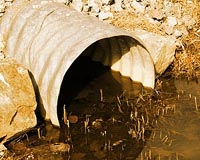| . |  |
. |
Washington (AFP) April 28, 2010 Fears the United States may be facing one of the worst oil slick disasters in its history threatened to whip up a new political squall Wednesday, at a critical moment for a Democratic climate bill. President Barack Obama dismayed some supporters and environmental groups when he announced in March that his administration would explore lifting bans on offshore drilling in certain waters in a wider overhaul of energy policy. But assurances by the oil industry that new exploration is environmentally safe are drawing new scrutiny as a predatory oil spill from a sunken Gulf of Mexico rig bears down on the precious wildlife haven of the Louisiana wetlands. The giant slick, growing by 42,000 gallons a day of oil seeping out of the rig that exploded in the Gulf last week, has grabbed headlines as Democrats seek to begin debate on Senate climate change legislation. The prospects of the bill, which aims to set a price for carbon pollution and develop alternative energy sources, are already complicated: Democrats and Republicans cannot yet agree on when to bring it to the floor. Proposals for offshore drilling, part of Obama's plan to wean America off oil from volatile foreign regions, are a comparatively small component of the bill -- too small for many Republicans -- but take the effort onto delicate political territory. New Jersey Democratic Senator Robert Menendez is one lawmaker from a coastal state who fears the impact of drilling on his community, and voiced his concerns in an interview published in Wednesday's New York Times. "Unless there is the ability for some neighboring states to have some type of veto in the process, unless there's some serious environmental consideration before any drilling takes place, unless there are very significant buffer zones, I'm going to have a hard time at the end of the day supporting the legislation," he said. Another senator from a coastal state, Florida Democrat Bill Nelson, raised concerns about the Gulf tragedy last week, which killed 11 workers. "I think we need to look back over 10 years or so to see if the record denies the industry's claims about safety and technology," he said. The White House last Friday said that Obama's plan, which would see tracts of waters off the Virginia, Alaska and Florida coasts opened to exploration, would not be put off course by the Gulf of Mexico accident. An administration official added on Wednesday that the kind of incident that occurred last week was extremely rare and that drilling rigs were subject to close oversight. The official said the administration's plan would follow a "thoughtful" process grounded in science to determine which areas were suitable for exploration and development. "Before production moves forward in a new region of the Gulf of Mexico, the Mid or South Atlantic, or the Arctic Ocean, an area will have to undergo thorough environmental analysis," the official said. There would also be time for public comment, a careful assessment of possible risks, and an assessment of the capacity of local authorities to respond to any oil spills, before leases begin to be handed out in 2012. Critics of the administration's plan will be closely watching an evolving effort to mitigate the worst ecological damage from the oil slick in the Gulf. Emergency teams were to begin Wednesday a controlled burn of a giant oil slick off the US Gulf coast, in an effort to limit the damage to the Louisiana coastline. The White House stressed Wednesday that Obama, on a two-day campaign trip to Iowa, Missouri and Illinois, had been repeatedly briefed on the unfolding effort and had asked for a probe into its cause. The official said that senior Obama administration officials had also held talks with British Petroleum, the operators of the Deepwater Horizon rig that went down. Administration officials are also touting clean energy plans, as well as the oil exploration part of the bill, which some observers saw as an incentive to Republicans needed to help get it through the Senate. Obama promoted his clean energy plans in Missouri on Wednesday, saying they would create or save more than 700,000 US jobs by the end of 2012. Interior Secretary Ken Salazar meanwhile gave the go ahead for a giant wind farm project -- the first such offshore program in the United States -- between Cape Cod and Martha's Vineyard and Nantucket off the northeastern coast.
Share This Article With Planet Earth
Related Links Our Polluted World and Cleaning It Up
 Deal opens pollution info to ordinary Europeans: UN
Deal opens pollution info to ordinary Europeans: UNGeneva (AFP) April 23, 2010 European citizens will soon be able to find out about pollution in their local areas at the click of a mouse and lodge complaints under a new international agreement, the UN said Friday. Dubbed a tool for "environmental democracy" by its supporters, the Kiev Protocol obliges authorities to keep a public register of pollution incidents or emissions from sources such as chemical plants, power ... read more |
|
| The content herein, unless otherwise known to be public domain, are Copyright 1995-2010 - SpaceDaily. AFP and UPI Wire Stories are copyright Agence France-Presse and United Press International. ESA Portal Reports are copyright European Space Agency. All NASA sourced material is public domain. Additional copyrights may apply in whole or part to other bona fide parties. Advertising does not imply endorsement,agreement or approval of any opinions, statements or information provided by SpaceDaily on any Web page published or hosted by SpaceDaily. Privacy Statement |